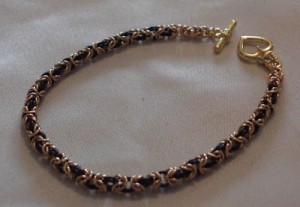 Siobhan Keogh from Vovs Jewellelry shares with us her tutorial for making chainmaille bracelets. Siobhan explains that. “this is a well explained tutorial on how to make chainmaille bracelets using the Byzantine Weave. It uses clear photos and point by point instructions.” I completely agree! I wondered how bracelets like these were made, now I know! Check it out and learn how to create your own Chainmaille Byzantine Weave Bracelet in variety of colors!
Siobhan Keogh from Vovs Jewellelry shares with us her tutorial for making chainmaille bracelets. Siobhan explains that. “this is a well explained tutorial on how to make chainmaille bracelets using the Byzantine Weave. It uses clear photos and point by point instructions.” I completely agree! I wondered how bracelets like these were made, now I know! Check it out and learn how to create your own Chainmaille Byzantine Weave Bracelet in variety of colors!
Comments
Have you read?
Hama BioBeads Review: The Eco-Friendly Fuse Beads You’ll Love

As a long-time crafter, I’ve worked with all kinds of materials, but there’s something about fuse beads that never gets old. The creativity, the colors, the nostalgia—it’s all part of the fun! But let’s be honest, traditional plastic beads aren’t exactly great for the environment. That’s why I was so excited to try Hama BioBeads, an eco-friendly alternative that promises all the fun of classic Hama beads without the plastic guilt. So, do they live up to the hype? Let’s dive in!
What Are Hama BioBeads?
Hama BioBeads are a biodegradable version of the classic Hama fuse beads. Instead of being made from petroleum-based plastic, these beads are crafted from a plant-based, eco-friendly material that naturally decomposes over time. That means less plastic waste while still enjoying the same vibrant colors and creativity that fuse bead lovers expect.
First Impressions: Do They Feel Different?
When I first opened the pack, I was curious—would they feel different from traditional beads? The answer: not really! The beads are slightly smoother to the touch, but they’re just as easy to handle, pick up with tweezers, and place on a pegboard. The colors are just as bright and bold, which was a big relief since I was worried they might look dull or faded.
One of the things I love about these beads is that they’re the same size as regular Hama beads, so they work with all my existing pegboards and accessories. No need to buy new tools or change my crafting process!
How Do They Fuse?
Now, onto the real test—how well do they iron together?
I followed my usual fusing process, using parchment paper and a medium heat setting on my iron. The beads melted together perfectly, just like regular Hama beads. No weird smells, no uneven melting—just smooth, well-bonded designs.
I also noticed that once cooled, the fused beads felt a bit sturdier than traditional plastic beads. That’s a huge plus because sometimes regular beads can feel brittle or break apart too easily.
What Makes Hama BioBeads Special?
? Eco-Friendly & Biodegradable – The biggest selling point! These beads naturally break down over time, reducing environmental impact.
? Non-Toxic & Safe for Kids – Made from natural materials, they’re a safer option for little crafters.
? Same Great Quality – They look, feel, and fuse just like classic Hama beads—no sacrifice in quality!
? Works with Existing Hama Accessories – You don’t need special pegboards or tools; they fit right into your current stash.
? Great for Schools & Eco-Conscious Crafters – If you’re an educator or a parent looking to introduce sustainability to kids in a fun way, these are perfect!
The only potential downside is that since these are a newer product, they may not be as widely available as traditional Hama beads. Some colors also seem to be in and out of stock, so if you see a set you love, I’d suggest grabbing them while you can.
If you love fuse bead crafting but want a more sustainable option, Hama BioBeads are a fantastic choice. They’re just as fun, colorful, and easy to use as regular Hama beads, but they come with the added bonus of being better for the planet. Whether you’re a hobby crafter, a parent, or a teacher, these beads are a guilt-free way to get creative.
So if you’re looking to make your crafts a little greener, give Hama BioBeads a try! Check them out here!
This link didn’t work for me – the message said ‘Sorry, the page you were looking for in this blog does not exist’.
However, I did go to the tutorials link at the top and there are a bunch of video and photo tutorials. I have bookmarked for future use. Thanks for posting, I think this may be a great resource for beginners like me.
FOUND IT!!
When you click on the link and get to the message I mentioned in my first comment, just click on ‘HOME’ and as of today, the Chainmaille Byzantine Weave Bracelet is the first tutorial shown.
heres a direct link the one above doesn’t go straight to the blog
http://vovsjewellery.blogspot.ie/2013/04/chainmaille-byzantine-weave-tutorial.html
Link needs the .html at the end to get you there…
Oops! I am so sorry about that! I fixed the link in the post and it now takes you straight to the tutorial! Thanks ladies!
sorry about the link everyone no idea why it hasnt been working hopefully the one i posted above will get you right to the page! thanks for visiting my blog and I hope you find something that is helpful feel free to leave a comment on any post if there are any questions about anything or something you would like to see in future posts!
Good day! I could have sworn I’ve been to this website before but after checking through some of the post I realized it’s new to me.
Anyhow, I’m definitely happy I found it and I’ll be book-marking
and checking back frequently!